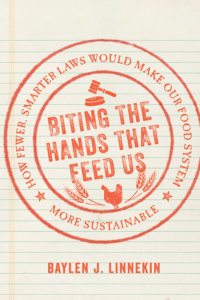How Many Beef Slaughterhouses Are in the Us
When Americans mumble about how our nutrient system is broken, the slaughter and processing of farm animals are oftentimes at the center of their critiques. One hundred years ago, Upton Sinclair's damning novel, The Jungle, exposed many gruesome and unsanitary practices in the food system of his solar day. A host of important federal food-prophylactic regulations, including mandatory inspections, soon followed.
Merely that was hardly the finish of the story. Instead, attention to livestock slaughter has but grown in recent years. In 2014, for example, I moderated a panel at Harvard Police School on sustainable meat product equally office of a conference called "The Meat We Consume." The conference was cosponsored by two Harvard Law student groups—the Food Constabulary Society, the first of many similar student groups that have popped upwardly at constabulary schools around the country in contempo years, and the Student Fauna Legal Defense Fund. The title of my panel—"Reducing Legal Barriers, Empowering Consumers, and Creating Pathways for Sustainably and Humanely Raised Meat"—nicely encapsulates the obstacles that many farmers, consumers, and others face up in their efforts to sell, buy, and swallow the type of meat they want. Many of these obstacles are the result of a mandatory food-safety inspection system, administered by the USDA, that is securely flawed.

Today's USDA food-condom rules require that agency inspectors be present at a facility every day that meat is processed. In 2007, though, stunning reports emerged that USDA inspectors had failed to audit hundreds of plants regularly, as required, for 30 years. Although the bureau'southward failure to inspect hundreds of facilities regularly for three decades is outrageous, even that fact doesn't illustrate the broken country of the agency's food-safety rules quite likewise as does the closure of a Petaluma, California slaughterhouse in 2014. That year, the USDA of a sudden forced Rancho Feeding Corporation—the only USDA-approved slaughterhouse in Northern California—to close. An agency investigation indicated the facility had illegally processed cattle that were suffering from cancer.
The presence of cancerous meat led the USDA to society the recall of 8.7 one thousand thousand pounds of beef candy by Rancho. The bureau was conspicuously justified in taking whatsoever malignant meat—which was disgusting at best and which could pose food-safety issues at worst—out of the food supply. By also ordering the recall of millions of pounds of beef that was entirely wholesome, though, the bureau was throwing out the babe with the bathwater. Worse nevertheless, every bit I'll explain, the USDA's own food-safety rules were largely to blame for the agency's decision to society the destruction of perfectly good meat.
USDA rules oftentimes forcefulness small, sustainable farmers to send animals hundreds of miles away—fifty-fifty out of country—to exist slaughtered.
Ane forenoon in 2009, when I was living in Fayetteville, Arkansas, where I was studying agricultural and food law, I jogged by a pair of cattle dining on grass in a fenced pasture a couple blocks from my apartment. As I slowed downwardly to take a look at them, I noticed some flyers attached to the fencing along the roadside. I stopped running and grabbed a flyer. Sure enough, these cattle or parts of them, at least— would soon be for sale in l-pound boxes. Later on I finished my jog, I called the phone number on the flyers. Another phone phone call, a few emails, and a week or two later, I was the proud possessor of a box of steaks and other cuts raised by Tommy Daniel, a recently retired professor of crop, soil, and environmental sciences at the University of Arkansas.
Y'all'd think that these cattle, raised lovingly and openly in a pasture a block from the main intersection in a college boondocks, might exist spared the indignity of enduring a road trip to meet their end at a far-off processing plant. They'd exist killed locally and sold to people like me. Yous'd be wrong. Though Prof. Daniel's cows lived out their days in a pasture merely 2 blocks from my home, that fact hides the journey they—and animals like them effectually the country—face if they're to become dinner. Prof. Daniel had to send his cows only sixty miles to be slaughtered. Other farmers—and their livestock—aren't so lucky. USDA rules often strength minor, sustainable farmers to ship animals hundreds of miles away—even out of state—to be slaughtered and candy alongside animals that were raised without the same care. That's because USDA rules unnaturally anneal animals from farmers and ranchers of all types and sizes—from cattle raised on the smallest grass-fed beefiness farm to those raised on the nation's largest bars beast feeding operations (CAFOs)—into many of the same USDA-canonical slaughterhouses. This is largely true because rules are uncaring, and because in that location simply aren't plenty slaughterhouses to come across need.
"When I take my animals to be candy, I bulldoze by a custom facility three miles from my firm and travel iii hours to a USDA facility."
At that place are more than 800 federally inspected slaughterhouses in the Usa, according to recent USDA information. Another 1,800 are operated by states or are "custom" slaughterhouses—where sales are severely restricted to prohibit, for case, sales to grocers. Just figures showing a proliferation of custom slaughterhouses are misleading. The xiii largest U.Due south. cattle slaughterhouses account for 56 percent of all cattle killed in this country. The figures are similar for hogs (twelve plants account for 57 percentage of all slaughters) and other livestock. Commercial plants processed 47.three billion pounds of cerise meat (including cattle, pork, sheep, and other hooved animals) in 2014.
USDA requirements for slaughterhouses the agency inspects are part of the problem. They're then complex that the agency itself funded a study in 2012 for the purpose of establishing "a streamlined regulatory proposal that could exist carried forward in hereafter years to make the USDA inspection system less onerous to smaller facilities that could perceivably exist congenital or utilized in more than minor local communities." That sounds great. But the study writers ended that their mission was damn near futile. "Subsequently the numerous conversations and meetings, it became credible that no one with the USDA or . . . working as professionals within the meat industry," they write, "believe[s] that streamlining regulations will ever occur."
On-subcontract slaughter accounted for just 93.4 million pounds of red meat—or a paltry 0.two percent of meat slaughtered commercially.
Despite this dire decision, small farmers practice have some choices for operating outside of the USDA arrangement. But these choices come with serious drawbacks. A 2013 report by the Spokane, Washington, Spokesman-Review detailed the problem. Farmers and ranchers are costless to use slaughterhouses that are not inspected by the USDA. But meat from animals slaughtered there "must be sold to the consumer earlier information technology is butchered." That means consumers must purchase cow, not beef. And they often have to buy hundreds of pounds at a time. "Since a steer yields nearly 400 pounds of meat, that'due south often too much for a single family unit," reported the Spokesman-Review . "Several families can go together to buy an animal, but that'southward more than hassle for the rancher. And it doesn't accost the needs of individuals who but want to purchase a few steaks or some ground chuck."
This helps explain why on-farm slaughter accounted for just 93.4 one thousand thousand pounds of red meat—or a paltry 0.2 percent of meat slaughtered commercially. This figure includes mobile slaughterhouses, vehicles that travel to farms to slaughter livestock without forcing them to undergo the discomfort and stress required past lengthy travel. All of this helps explicate why Rancho was the only independent USDA-inspected slaughter-house in all of Northern California in 2014. It also explains why nigh pocket-size cattle farmers are forced to use USDA facilities and pass up the local slaughterhouse. Some even literally drive by the latter on their way to the former. "I'm a beefiness farmer myself," Rep. Thomas Massie (R-KY) told me in 2015, "and when I take my animals to exist processed, I drive past a custom facility three miles from my house and travel three hours to a USDA facility."
He'south out almost $400,000 even though the hundreds of his cattle that Rancho slaughtered were cancer-free.
How did nosotros go to this point? As the Washington Postal service reported in 2010, the "processing, marketing and distribution networks that once fabricated pocket-size farming viable . . . disintegrated in the last 30 years equally U.S. agronomics went through a dramatic consolidation." This dramatic refuse has occurred even equally "demand for pasture-raised niche meats is soaring," reported USA Today that same year. In other words, the demand for niche meats is rising fast, but supply is being suppressed artificially past the lack of slaughterhouses.
These problems aren't merely axiomatic with cattle and squealer slaughter. Consider poultry. Small farmers tin can slaughter up to xx,000 of their own chickens in a year. And if you're raising and slaughtering that many birds, chances are you lot tin can justify the cost of investing in your ain processing facility. But very small operations tin can't afford to exercise and so. And that hurts the smallest poultry farmers, considering slaughterhouses are ofttimes hard to find. For example, Massachusetts lacks a USDA-approved poultry slaughter facility.
That programme is a bad one for small, sustainable farmers and consumers.
The touch on of limiting where animals can be slaughtered has real world consequences beyond mere inconvenience, including the Rancho remember. The USDA's mandatory recall ensnared not only malignant cattle candy from (and by) a few bad actors but besides that of every other producer who'd had an beast slaughtered in the Rancho constitute in the past twelvemonth—out of what the San Francisco Chronicle termed "an abundance of circumspection . . . to make certain none of the cancerous meat commingled with healthful beef." That includes cattle sent to Rancho by celebrated grass-fed farmer Bill Niman, who told the Relate that he's out most $400,000 even though the hundreds of his cattle that Rancho slaughtered were cancer-complimentary and he could prove to the USDA that those cattle were not commingled with the diseased meat. Niman's married woman, Nicolette, an ecology law attorney and writer of the book Righteous Porkchop , penned an first-class New York Times op-ed lamenting the call back as an overbroad reaction akin to chopping downward hundreds of unlike orchards thanks to one bad apple. "The Agriculture Department's tools for safeguarding the nation's meat supply are blunt and clumsy instruments, especially when dealing with independent farmers," she wrote. These USDA policies aren't merely stupid—they're also reckless. And the alleged "abundance of caution" the department claims to be exercising at present—subsequently the fact—is entirely the event of its own recklessness.
The Rancho retrieve is role of a much larger problem that's existed for decades in the USDA inspection procedure. That plan is a bad one for small, sustainable farmers and consumers. As you'll learn in chapter 5, the USDA inspection plan is now under fire from a bipartisan group of lawmakers in Congress who support small farmers, including some, such as Rep. Massie, who are themselves minor farmers. Every bit yous'll learn, Rep. Massie, a Republican, and Autonomous colleagues such as Rep. Chellie Pingree (D-ME) and Jared Polis (D-CO), have cosponsored a bill that would allow farmers to aggrandize options for selling meat locally that'southward been processed by local slaughterhouses.
Although USDA food-safety rules brand selling sustainably raised meat a tough slog, you're well-nigh to learn that state and local food-prophylactic rules are often no less complicated. Food-safety rules that govern the sale of fruits and vegetables, meats and cheeses, and other foods you buy at farmers markets and other local outlets can brand doing business difficult— or impossible—for local farmers.
Source: https://thecounter.org/americas-slaughterhouse-mess/

0 Response to "How Many Beef Slaughterhouses Are in the Us"
Post a Comment